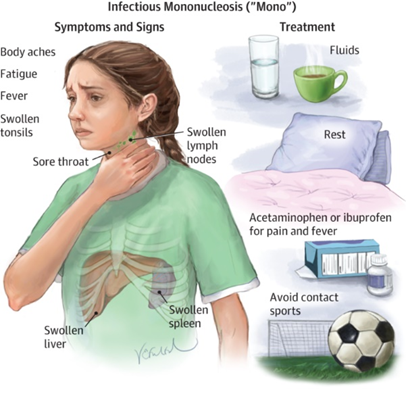Disclaimer [ENGLISH]
Disclaimer: This material is for educational purposes only. You, the reader, assume full responsibility for how you choose to use it. It is not intended to provide medical advice, diagnosis or treatment, nor does it replace the advice or counsel of a doctor or health care professional. Reference to a specific commercial product or service does not imply endorsement or recommendation of that product or service by CPCMG.
What is Mononucleosis (Mono)?
- Mononucleosis (Mono) is a viral infection.
- Mono is usually caused by the Epstein Barr Virus.
- Anyone can get mono, but it is most common between 15 and 30 years old.
- You may have heard people call it it “the kissing disease”. That’s because it is spread through saliva (most common), blood, and other body fluids.
- Most people are infected at some point in their lives.
What are the symptoms?
- Your child may have a sore throat.
- Your child’s tonsils may look red, enlarged, or have pus on them.
- Your child may have fever, chills or body aches.
- Your child may have enlarged lymph nodes along their neck, groin area or in their armpits.
- Your child maybe more tired than usual.
- Your child may complain of a headache or light sensitivity.
- Your child may show less interest in eating and/or drinking.
- Your child may have an enlarged spleen or liver (found when your child’s abdomen is examined).

How is it diagnosed?
- Usually mono can be diagnosed in the office with a blood test. This is done by poking your child’s finger.
- Sometimes, your child’s doctor will have you go to the lab for more studies on blood drawn from a vein.
How can I prevent it?
- Good hand-washing.
- Clean high contact surfaces regularly.
- Avoid any contacts who are sick.
- Avoid sharing food or drink.
How can I treat my child’s symptoms?
- Encourage lots of fluids.
- Your provider may encourage tylenol or ibuprofen (depending on your child’s age) for fever or discomfort.
- Encourage your child to rest.
- If your child is over 1 year old, you can give honey – in a spoon or mixed in warm fluids – to help with sore throat. Click here to learn more about sore throats and how to help your child feel better.
- Children who are able to gargle, can try salt water gargles
- Comfort measures: baths, cool or warm compresses
Recovery and what to expect:
- Sometimes it can take several weeks (or even a few months) for your child’s energy and activity level to return to normal.
-
Your child needs to avoid strenuous activities, and activities that could lead to abdominal injuries for 21 days. They need to avoid contact sports for 4-6 weeks after getting sick.
- Sometimes this infection can cause the spleen to become enlarged. This can make any impact injuries to the abdomen very dangerous.
- If your child participates in sports, please make an appointment in the office in 4 weeks for clearance prior to returning to sports.
When to call your child’s provider:
- Your child is having trouble breathing or drooling more than is normal for them.
- Your child is not able to stay hydrated .
- Fever lasts 5 days, or goes away for 1-2 days and then returns.
- Your child is complaining of abdominal pain, dizziness, or looks pale.
- You think your child needs to be seen.
- Your child becomes worse.
- A month after your child had mono to check the abdomen and make sure the spleen is normal in size prior to returning to sports.
This publication was adapted from information within American Academy of Pediatrics Patient Education Handouts, UpToDate Guidelines and Healthychildren.org
Reviewed by: TT D.O, AR D.O. | 09/2023


